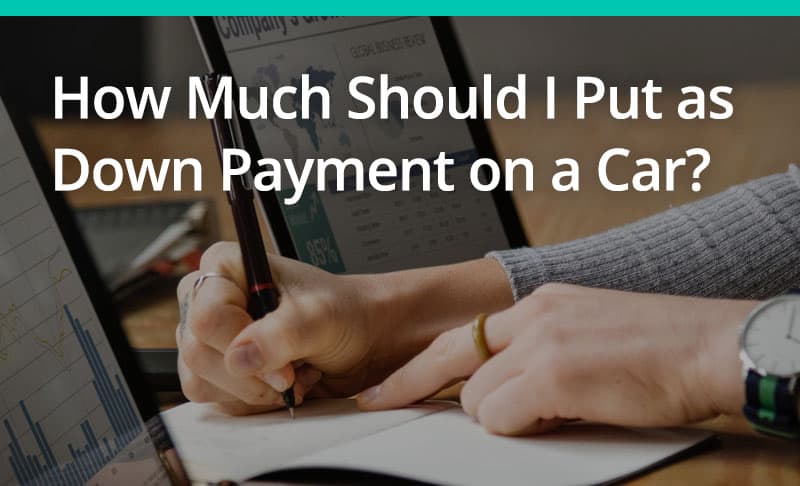
How Much Should I Put As Downpayment on a Car
For most Canadians, a new vehicle is a major purchase. In fact, second only to a home, a vehicle is the largest purchase most Canadians will ever make. So, it shouldn’t come as a surprise that for many people the purchase process can be stressful.
Shoppers in the market for a vehicle have a lot to think about. How Much Car Can I Afford? Will you be shopping new or used? Is it worth getting extended warranty? What size payments can you comfortably afford? Should I Finance my Car With a Dealer or Banking Institution? Caught in the chaos of all those questions, it isn’t surprising that one of the last questions car shoppers think of is: how much should I put as a down payment on a car?
The old school of thought on this matter was simple. When you buy a car, put down 20%. But the fact is, for most people 20% is a large down payment in today’s car market. Not only that, but it’s tough not to wonder if a down payment is necessary at all with contradicting statements from other dealers & banks.
In this article, we’re going to explore:
- The benefits of smaller down payments?
- The benefits of larger down payments?
- What’s a negative equity on a car loan?
- How do I avoid a negative equity situation?
What are the benefits of smaller down payments?
Financing the cost of a vehicle with a lower down payment, or in some cases no down payment at all, helpsyou to keep some cash in your pocket a little longer. This essentially the biggest benefit of a smaller down payment. Later in this article, we’ll look at some of the ways increasing your down payment can actually help your bottom line, but that doesn’t mean that hanging on to some your cash can’t help your situation around purchase time.
Here’s a few ways it might:
1. Repairs
This is especially important if you’re purchasing a used vehicle. New vehicles typically require less maintenance work in the early years of their lives, so budgeting for car maintenance and repairs is less of an issue. Used vehicles can be a different story. Even if the last owner of a used vehicle took great care of it, that ride could still require basic wear and tear maintenance, like new brakes and tires. These can be costly issues that need to be addressed immediately or soon, or your new ride can quickly become a placeholder in your driveway.
To avoid purchasing a used vehicle that’s going to cost you in repair bills during your first years of ownership, avoid private sales and shop for a used vehicle at a reputable dealership instead. Some dealerships can even offer you warranty on your used vehicle in-house.
2. Insurance
A car payment is a big expense to introduce to a monthly budget. Add a monthly auto insurance payment on top of that, and a person on a fixed income could be looking at a significant lifestyle change. With that in mind, the idea of rerouting some money from your down payment toward your first-years insurance can be tempting.
Some insurance providers offer discounts on full-payments for your annual insurance bill. Pay the year up front, then squirrel away what would be your monthly payments into a savings account. At the end of the year, you should have enough to pay the following year’s insurance plus some extra to put toward the next time you’re ready to upgrade your vehicle.
That being said, be careful. Saving money is always easier said than done. If you’re concerned that an insurance payment on top of your car loan might be too much for your budget, avoid it. Revisit your decision to purchase the vehicle and see if there’s another vehicle that better fits your budget, while still delivering everything you need.
What are the benefits of larger down payments?
Years ago, 20% down was a reasonable ask when it came to buying a new car. People also used to commonly finance their vehicles over periods of three to five years. But as vehicle prices continue to climb, it’s getting tougher for people to save for a down payment and afford their monthly payments.
To accommodate consumers in this economic climate, dealerships are financing vehicles over longer terms and accepting smaller down payments. According to numbers from the federal government, between 2009 and 2015 the average loan term for vehicles increased from around 65 months to over 72 months.
What does this mean for drivers? More affordable payments but also more money paid out in interest over the life of the loan. Not to mention, it could mean longer time spent in a negative equity situation as you’re paying off your vehicle.
What’s a negative equity on a car loan?
Negative equity is when you owe more on your vehicle than what it’s worth. According to estimates by Edmunds, new vehicles can lose close to 30 percent of their value after a single year on the road. If you financed your vehicle with zero down, over an average six-year loan term, you haven’t even paid for half that depreciation yet.
How do I avoid a negative equity situation?
You can avoid, or at least minimize time spent in, a negative equity situation by paying a down payment when you enter your car loan. Doing so will allow you to accomplish the following:
Offset initial depreciation
If you’re purchasing a new vehicle, you’re vehicle will depreciate the moment it leaves the lot. Unfortunately, there’s no avoiding this. Depending who you ask, you can expect to see depreciation to the tune of 10-15% as soon as that odometer starts spinning. By spending a similar amount on a down payment, you’ll effectively offset that initial depreciation.
Reduce negative equity period
Between new vehicles experiencing rapid depreciation during their first years on the road, and interest eating up the lion’s share of car payments during the first years of your vehicle financing, staying in a positive equity situation with your new vehicle can be difficult. Luckily, budgeted for a significant down payment and substantially offset your initial depreciation, drastically shortening your negative equity period.
Protect yourself against disaster
Don’t forget; longer loans mean more interest as well as a longer negative equity period. If you get into a serious car accident, and your vehicle’s assessed as a total loss, your insurance company could pay you out less than the balance on your loan. This means, you’ll be entering your next vehicle purchase in the red. To protect yourself against this type of disaster, combine a calculated down payment and loan term to minimize your negative equity period.
Trade up more often and progressively improve your ride using positive equity
This is the fun part. By paying a little extra money – in the form of a down payment – you’ll reach a positive equity situation with your new ride sooner. You’ll be able to head back to the dealership using your new trade-in as part of your next down payment. Ultimately, budgeting for a down payment will allow you to not only purchase a new vehicle more often, but also help you build the positive equity that will help you afford more expensive vehicles over time.
Everybody’s financial situation is different, but as a general rule of thumb, pay what you can for a down payment. If you have less than perfect credit, attempt to put down the minimum amount as it will make a difference in the long run. But if your credit’s in better standing and you have some financial flexibility, consider not taking the bait when the dealership offers you a zero down car loan. A down payment on your next vehicle is an investment that’ll pay you dividends throughout the length of your next loan.
Whether or not a down payment works with your budget, Birchwood Credit Solutions can help.Our customer have various financial backgrounds. The numbers on their credit scores vary, but don’t affect their ability to receive a car loan. Fill out our online application and one of our Finance Managers will connect with you within 24 hours.
- What is the Minimum Income for a Car Loan
- How to Protect Your Vehicle’s Resale Value
- How to Budget for Car Maintenance
- Car Loan Calculators and Tools to Help You Buy a New Car
- No Money Down Car Loan 101




